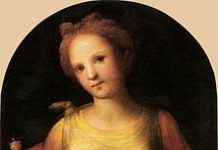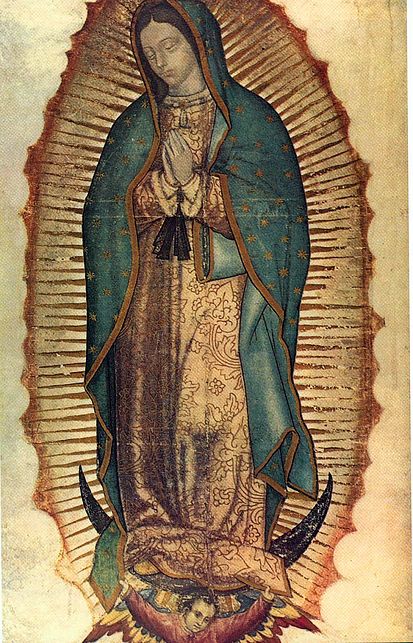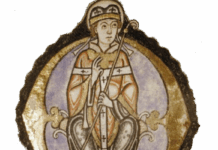
Quebec is a paradox, much like France, whose offshoot she is. So Catholic on the outside: majestic churches towering over the countryside and cities, place names evoking saints and a bygone era, and even pockets and remnants of the true Faith here and there. Yet that same Faith no longer infuses and informs the culture, which has descended into a secular paganism, as the loss of the Faith inevitably does.
As mentioned in a previous nota, I just returned from a whirlwind pèlerinage to la belle province, and here are some scattered thoughts before they recede too far in the memory. Perhaps they shall prove helpful, should you decide to make your own pilgrimage, in your own way. I would recommend something more leisurely, especially on your first visit.
Day 1:
I drove to Montreal on a Monday, and parked on the far west end, planning to cycle my way to the ‘old city’. I turned my car into an industrial area, filled with trucks and loading docks, but which eventually led, by a propitious left turn, into a residential neighbourhood. Quickly setting off on my trusty bicycle, I discovered a waterfront trail, going on for miles to the downtown. I stopped at one of those grand churches you see everywhere in Quebec, this one overlooking the Saint Lawrence – for such was the river, named by Samuel de Champlain himself for the martyr saint, whose feast is around the corner. I arrived just in time for the Angelus, and, to my surprise, the bells rang out the prayer, deeply and sonorously.
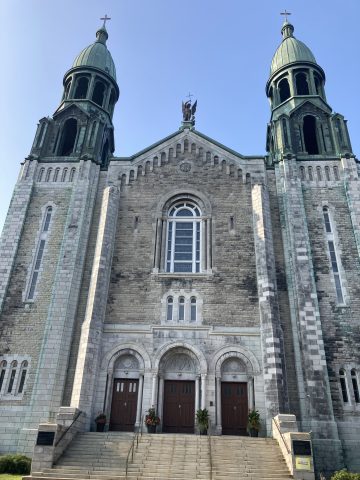
It wasn’t ‘till afterward that I thought how many Montrealers still say the daily prayer, and how many just wonder why the bells are ringing; or perhaps they have just gotten so used to their sound it is no longer really heard, like an old grandfather clock that still chimes way.
I continued my cycle for miles, the fast-moving river to my right, and lovely homes on the left, stopping to help some young people whose bike chain had become jammed, learning a new trick myself from a fellow cyclist, using Archimedes’ principle. There were surfers, who rode the rapids of the river, and people, young and old, sitting on the grass, as well as smoking some grass; the pungent, skunky odour would become a familiar smell over those few days. I came to a part of the trail that evoked fond memories from yesteryear; my brother – who then lived in the city – and I had walked that section with a group many years ago, on a walking pilgrimage to the shrine of Saint Kateri at Kahnawake, about 16 miles outsides Montreal. By the time I reached the church of Notre Dame de Bon Secours, where Saint Marguerite Bourgeoys rests, it was locked, so I prayed outside. The same with the grand basilica of Notre Dame, to enter which one must pay admission – an injustice in any Catholic sense – and which was just closing up, regardless. One can go in for free, if one attends Mass.
From there, it was up, and up – semper altius! – to the top of the mountain, after which Montreal – Mont Royal – is named, where there is a wide plateau overlooking the city, which offers a grand sight, lit up at night. The hurried photo does not do it justice, but provides a glimpse.
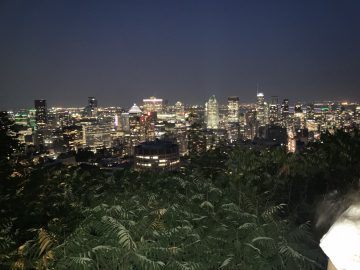
It was getting late, so back down the mountain, stopping at Saint Joseph’s Oratory on the way. I climbed to the top of the stairs – there are lots of them, and the men from my area make an annual pilgrimage to the shrine, saying the Rosary on their knees on the way up. At the very top, one can peer through the doors, to just about see the Blessed Sacrament behind the modern-rococo metal screen (the décor and architecture of the main basilica leave much to be desired, and Saint André, who died before it was finished, must be looking down from heaven with a sardonic smile).
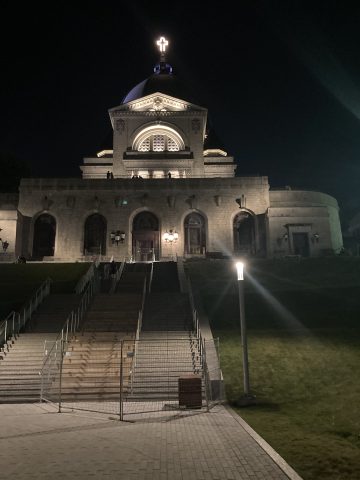
There were others on the stairs, couples canoodling, and more than a few Muslims chatting away in Arabic, who, I thought, were at least within shouting distance of Christ Himself.
After a long cycle back to the car through a maze of streets, I departed Montreal close to midnight, and drove to the shrine of Cap de Madeleine, arriving there sometime after 1 am. I dozed in the car, and woke up before the sun, to the shrine almost deserted – it would not open until 8 or 9 am. So I walked around the lovely grounds, praying. I noticed that some things looked a little neglected – cobwebs on the statues, the island with Our Lady in the middle of the pond overgrown. I thought, perhaps that is because religious brothers and sisters – there were many such one time in Quebec – used to take care of the place like it was their home. Paid staff tend to lack such solicitude. I know not. But the miraculous statue of Our Lady of the Cape perched above the tabernacle in the old, still-preserved, original chapel, could be seen clearly through the glass walls, and provided much comfort and solace that all manner of things shall be well in the end.

Day 2:
It was then on to Quebec City, along Highway 138, which offers a much more scenic route than the main highway 40, meandering through the towns and villages by the Saint Lawrence. A casse-croute had the door ajar, so I went in. It turns out they were not open on Tuesdays, but the manager gave me a smile at my limited French, and made a lovely coffee, which went fine with an egg croissant, on a picnic table, with the water in the near distance.
I made it to the capital in time for a late morning traditional Mass at the FSSP parish of Saint Zephryn. There were but a few older people in attendance, faithful and devout. I again parked far from downtown, and began a long walking pilgrimage. My first stop was a large church, which I thought had likely been turned into a library or office space or just left abandoned, as so many have. I prayed at the front doors, then went along the side, and there on one of the doors was a paper note that said, in French (everything is in French in Quebec, by decree of draconian law) ‘Adoration from 11 to 2, Tues and Thurs’. Well, it was about 1 pm, so I went in, and discovered one of the loveliest churches I had ever seen, all to myself, in the darkened vast interior. It had everything: beautiful, artistic stained glass; high altar with a sanctuary big enough to hold nearly the entire Curia; double choir loft, with an organ – I discovered – that was one of the finest in all of Canada; and the woodwork, statuary, all profound and pristine. The church was dedicated to Saint Roch, of whom I have written before, but who is largely forgotten now, but there was a great devotion to him through the centuries. Finally making my way to the adoration chapel at the side of the sanctuary, I prayed with the few – again older – people. One of the men had written up a fine booklet on the stained glass, which he gave me; they were very proud of their church. A treasure, indeed.
From there, it was a hot and sweaty perambulation through the vieux-ville of Quebec, my destination ultimately being the Holy Door of the Cathedral of Our Lady, which is open this year in celebration of the 350th anniversary of the diocese. I say ‘diocese’, for back then, in the 17th century under Saint François de Laval, the area stretched down through most of the U.S.A., into what is now Louisiana. This old part of the city is built on a steep hill, and if one starts down near the waterfront, as did I, it is quite the climb to the top. The Holy Door itself has a bas-relief of Christ, and His hand reaches out, forming a kind of handle by which one may open the door. The only difficulty is that it’s on the wrong side, so one must push rather forcefully, which is a sort of metaphor, I suppose. I prayed at the tomb of Saint François, especially for the soon-to-be bishop of our own diocese, and for all those who lead the Church of God.
Two events marred my time, both buskers, who perform in the walkway in front of the Chateau Frontenac. Both men, and both performed a quasi-strip tease – I say ‘quasi’, for they did not go full Monty. The first was a middle-aged French comedian with wiry, gray hair, and I caught but a glimpse of his act before walking away. The second performer whom I saw later on, was at first more amenable. He presented himself confidently, a handsome, powerful-looking acrobat, who was not small, like most such, over 200 pounds from what I could reckon, and he could do cartwheels and the splits, and climb a free-standing pole – held up by four volunteers – with the agility of an ape. Now that I think of it, he was sort of like Tarzan would have been in real life. Wearing a heavy denim shirt and pants, he was perspiring mightily, but kept his cool, spoke well, back and forth in French and English, fluently, with perfect accents in both. He asked for a child volunteer, and a boy first jumped in the fray, but soon ran back to his parents. So a pretty young girl, about seven, jumped out from the bystanders, and when asked by the acrobat her name and where she was from, said, ‘Elodie, from Florida’, which makes sense, as Quebecois children are thin in the ground. Her mother filmed from the stands, and the job of Elodie was to clang a pair of cymbals when the acrobat did something cool.
It all went well until the acrobat began to dramatically disrobe to raucous music, pulling off the denim. He at least had some shred of decency to ask Elodie to ‘turn around’, as he struggled on the ground to get his trousers off. But there were other women and children in that audience, beneath the hot summer sun. He was stripping down to one of those wrestlers’ costumes, which leave not much to the imagination. For some reason – divine intervention? – the music stopped, and the acrobat seemed embarrassed and disconcerted. I thought of standing up and yelling, or even challenging him to a David vs. Goliath boxing match, which may well have been more entertaining than his ‘show’, leaving to the reader to discern who might be the victor in that contest – only to say that I had no sling, only a Rosary. More likely, I may have reasoned with him, hombre a hombre, saying how much better his act would be without sexualizing the whole thing. (There is a metaphor there, which I will leave the reader to flesh out). Samuel de Champlain, the first governor of Quebec, a staunch Catholic, beneath whose glorious statue the acrobat was performing, would have had him in the pillory. In the end, having no such authority, I turned and walked away, praying, and hoping others did the same. Where have all the fathers gone, I later thought, to paraphrase that Sixties song, long time passing?
Just before this, I had gone to the tomb of Saint Marie of the Incarnation, in the old convent of her Order, still kept immaculate. The contrast was stark. There her body rests in a marble sarcophagus in a small chapel beside the larger conventual one. Above her, ringed around in balcony, if my own memory serves, are relics of some of the Jesuit martyrs, some of whom Sister Marie knew personally – she corresponded with Father Jean de Brébeuf, and was inspired to leave France for New France by their own intrepid example. A woman of dauntless courage, Saint Marie brought the Faith to this land, and I can only hope those losing their religion, along with any sense of decency, find it again.
I stayed that evening in a small motel outside Sainte Anne de Beaupré, the last stop – or almost – on my pilgrimage, about 20 miles north of Quebec City. The room was fine for my needs. The proprietress was an old Quebecoise, who laughed at my attempt at humour in French. She gave me room 14, which was actually room 13, which was skipped. I don’t think she had ever heard of the term triskaidekaphobia, but smiled at realizing her motel practiced it in their room numbering. I quite like the number 13, as it’s the day of the month Our Lady chose to appear at Fatima, and I don’t believe in luck, good or bad, only God’s good and holy providence, and our choices in response to God’s grace – audaces fortuna iuvat, as Virgil wrote.
Day 3:
The final day was spent in and around the church dedicated to the mother – and father – of the Mother of God, Saints Anne and Joachim. To venerate the relic of the forearm that had held the Virgin Mary is a great grace, and Saint Anne answers prayers in ways that we might not expect, or even sometimes desire – but answer them she does.
After a good rest at the motel, I woke up on time for the early Mass, walking to the shrine, the magnificent church looming on the horizon of the highway as the sun arose, and arrived as the caretaker was opening the doors.
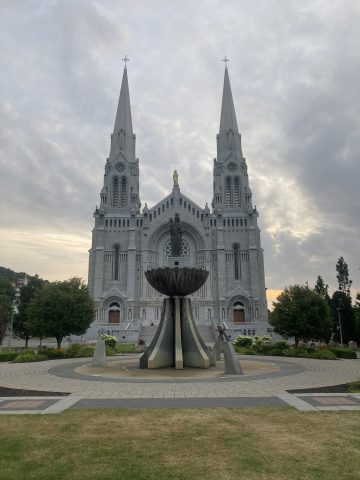
I went downstairs to the small Blessed Sacrament chapel, where Mass was about to begin, and noticed a large video camera at the back. The priest – well intentioned, I suppose – began the Holy Sacrifice by smiling and playing to said camera, and it was a bit too much for me, still suffering from PLISD – post-liturgical insanity disorder – flashbacks of the unhinged days of Covid and enforced televised Masses of solitary priests in empty churches sometimes come back quite vividly. It was also a living argument for the saying of Mass ad orientem et ad Deum, non ad camerum. Regardless, I quietly slipped out, to attend the later, more public Mass in the main church. It, too, was a bit of a glee-fest, replete with a gesturing soprano who led the singing at the ambo, and priests who no longer know how to give Communion on the tongue (lack of an altar rail doesn’t help); well, we receive what we are able, and are grateful for what we are given.
The Stations of the Cross on the grounds are some of the most picturesque I have ever seen, full-sized, realistic and dramatic, winding up the hill. And they have the Holy Stairs, just like in Rome. It’s more difficult to ascend those steps on one’s knees, as per custom, without using one’s hands than I had imagined.
To return to the paradox that is Quebec, which is so Catholic, yet so not. If an alien were to descend from space and wander around, he would think the province inhabited by devout saints, who scrimped and saved to build magnificent churches and shrines, and who gave their all for God and His Church – and one time, not that long ago, it was so. Quebec was founded in 1608, and la révolution tranquil that heralded the dissolution of this Catholic society was but a generation ago. It was called the ‘tranquil’ revolution, since there was no outright rebellion, far less any bloodshed – only a gradual drifting away, to an indifferentism. This, warned Cardinal Newman in a sermon in 1873, is amongst the worst conditions of a soul, or a society. As the prescient Oratorian put it, “I know that all times perilous, and that in every time serious and anxious minds, alive to the honour of God and the needs of man, are apt to consider no times as perilous as their own…”
What makes our time especially ‘perilous’, was that “Christianity has never yet had experience of a world simply irreligious”. [i] How does one argue with, far less inspire, a shrug, a sigh, especially one that reeks of marijuana? Secularism, hedonism, indifferentism have made deep inroads into Quebec society. It is now apparently illegal to teach Catholicism as ‘true’, even within the confines of one’s home to one’s own children. If all religions are true, then none of them are.
There is still hope for Quebec – there always is, except in hell, where it’s no longer possible, and in heaven, where it’s no longer necessary. In this transitory life, what was, may be so again, in a more purified way, without the entanglements of the state. The Faith is in the very blood and land of these descendants of les habitants, even if they are dwindling into a demographic death spiral. You don’t need many – a remnant will do – to bear fruit once again.
On the long drive home later on that last day, I thought of visiting the tomb of Blessed Dina Belanger, which I had done two years before – I had a special intention for the music program here at our College – and pulled over to ponder. (There is so much to see and visit in Quebec, and these few words on a few days but scratch the surface). I noticed a large church – they are indeed nearly everywhere! – not far from the random exit, so pulled up in front, only to realize it was dedicated to one of my favorites, Saint Ignatius of Loyola, and it just so happened to be his feast day.
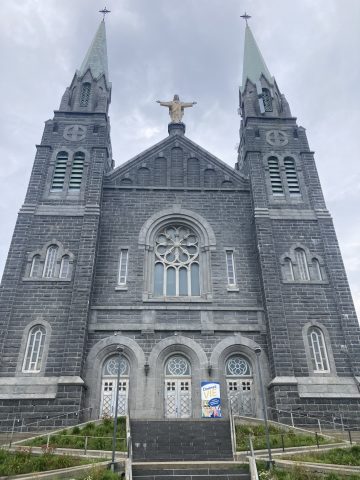
God is good, and takes care of us in ways we will only see in eternity. But sometimes, for Him to do so, we, like Bilbo and Frodo, must let go of the comforts of home, and depart from our various shires on pilgrimage to lands unknown, or familiar, far-off places we may come to know in a new way.
[i] As quoted in “To Sanctify the World: The Vital Legacy of Vatican II”, by George Weigel, Basic Books, NY. 2022, p. 16.

